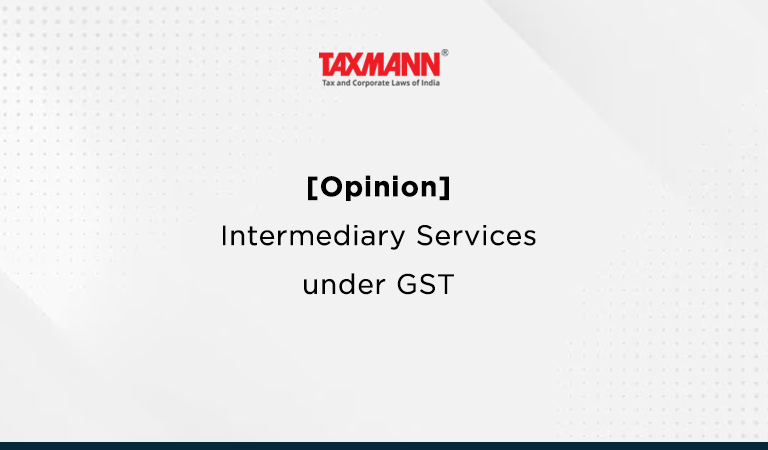[Opinion] Intermediary Services under GST
- News|Blog|GST & Customs|
- 3 Min Read
- By Taxmann
- |
- Last Updated on 25 February, 2023

CA Bhawna Goel – [2023] 147 taxmann.com 499 (Article)
In the GST regime, intermediary services by Indian suppliers to foreign principals are taxed to GST. In common parlance, any person who enables the supply of goods/services between two persons, is considered as intermediary. There has been a lot of confusion regarding tax implications on the pre-sales and post-sales services vs intermediary services done by Indian suppliers to foreign customers. The importance of an intermediary is significant in the international business market to build business relations with customers in a particular geographical area.
The concept of ‘intermediary’ was borrowed in GST from the Service Tax Regime. The definition of ‘intermediary’ in the Service Tax law as given in Rule 2(f) of Place of Provision of Services Rules, 2012 issued vide notification No. 28/2012-ST, dated 20-6-2012.
Who is an intermediary?
In the terms of section 2(13) of IGST Act, “intermediary” means a broker, an agent or any other person, by whatever name called, who arranges or facilitates the supply of goods or services or both, or securities, between two or more persons, but does not include a person who supplies such goods or services or both or securities on his own account;
In short, “intermediary” essentially involves 3 or more persons
(1) Supplier of service/goods,
(2) Principal on whose behalf service is rendered/goods supplied and
(3) Persons who actually receives the service/goods (i.e., customers of the principal).
However, where a person is providing services or supplies goods on his own account to his customers, it cannot be termed as an intermediary in accordance with section 2(13) of IGST Act.
The words “arranges or facilitates’ the supply of goods or services or both, between two or more persons, is the crux of the definition of intermediary. The Central Board of Indirect Taxes and Customs has clarified on scope of intermediary services via its Circular no. 159/15/2021-GST published on 20.09.2021. The circular has provided for some pre requisites for scope of intermediary services,
1. Minimum of Three Parties: Intermediary does not carry out the main supply himself but arranges or facilitates the main supply of goods and services between two or more persons. The arrangement requires a minimum of three parties, two of them transacting in the main supply of goods and services and one arranging or facilitating the main supply. An activity between only two parties can, therefore, NOT be considered as an intermediary service.
2. Two distinct supplies: There are two set of supplies-
a. Main supply, of goods or services, between two principals, which can be a supply of goods or services or securities;
b. Ancillary supply, is the service of facilitating or arranging the main supply of goods or services between the two principals. This supply is identifiable and distinguished from the main supply and is supply of intermediary service.
3. Intermediary service provider to have the character of an agent, broker or any other similar person: The Act itself defines intermediary as a broker, agent or any other person facilitating or arranging the services. The word ‘means’ in the definition is not inclusive and does not expand the definition to include any other person. The phrase “arranges or facilitates” indicates that intermediary services are only supportive services.
4. Does not include a person who supplies such goods and services or both or securities on his own account: The definition of intermediary services specifically excludes a person who supplies such goods or services, or both or securities on his own account. The person supplying services, fully or partly, on principal-to-principal basis, cannot be covered under the scope of “intermediary”.
5. Sub-contracting for a service is not an intermediary service: The main supplier of goods or services or both can outsource the main service, fully or partly, to sub-contractor. Such sub-contractors are carrying out the main supply of goods or services and provides the main service on his own account to the buyer on behalf of main supplier. Such services are not intermediary and part of main supply only.
6. When location of either of supplier or recipient of intermediary services is outside India: specific provision of Section 13 of the Act, relating to provision of place of supply of intermediary service, shall be invoked.
Click Here To Read The Full Article
Disclaimer: The content/information published on the website is only for general information of the user and shall not be construed as legal advice. While the Taxmann has exercised reasonable efforts to ensure the veracity of information/content published, Taxmann shall be under no liability in any manner whatsoever for incorrect information, if any.

Taxmann Publications has a dedicated in-house Research & Editorial Team. This team consists of a team of Chartered Accountants, Company Secretaries, and Lawyers. This team works under the guidance and supervision of editor-in-chief Mr Rakesh Bhargava.
The Research and Editorial Team is responsible for developing reliable and accurate content for the readers. The team follows the six-sigma approach to achieve the benchmark of zero error in its publications and research platforms. The team ensures that the following publication guidelines are thoroughly followed while developing the content:
- The statutory material is obtained only from the authorized and reliable sources
- All the latest developments in the judicial and legislative fields are covered
- Prepare the analytical write-ups on current, controversial, and important issues to help the readers to understand the concept and its implications
- Every content published by Taxmann is complete, accurate and lucid
- All evidence-based statements are supported with proper reference to Section, Circular No., Notification No. or citations
- The golden rules of grammar, style and consistency are thoroughly followed
- Font and size that’s easy to read and remain consistent across all imprint and digital publications are applied



 CA | CS | CMA
CA | CS | CMA
